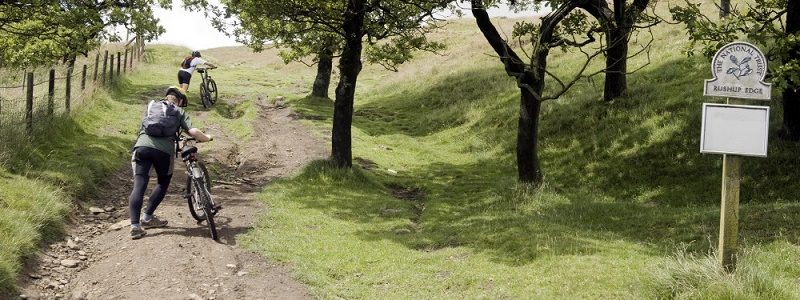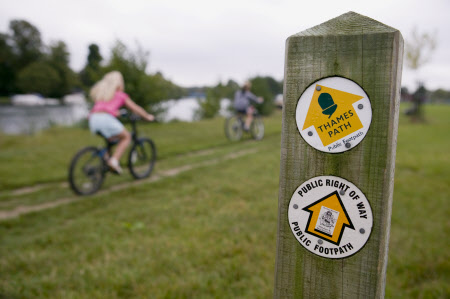By Colin Palmer, currently working with Open MTB, previous roles include working for the CTC, British Mountain Biking Federation, the International Mountainbiking Association and the International Orienteering Federation.
(in Volume 26)
From small beginnings in the mid 1980’s, some 40 million off-road journeys are now estimated to be cycled per year in the UK, many of them by families with children as well as the mountain bike enthusiasts.
Despite this dramatic rise in use, the path network available for those wishing to cycle on traffic free routes would not have risen at all if it were not for the facilities developed by Sustrans and the Forestry Commission. Indeed it has been estimated that around 70% of all off-road cycling is now undertaken on the public forestry estate, demonstrating that cyclists recognise that they are welcome, with well signed trails usable in all seasons and weathers.
The arguments for encouraging cycling, both on and off the road, are well rehearsed in terms of health and well-being in addition to a significant contribution to local rural economies.
Currently, only 22% of the 117,000 mile public rights of way network in England & Wales may be legally cycled, and yet if anyone was parachuted onto a right of way they would have few clues as to which category the path was listed. Many bridleways and byways are relatively unsuitable for cycles, as are many public footpaths, but equally many public footpaths are perfectly adequate for cycle use.
This mismatch results from the 1949 National Parks & Rights of Way Act which used historical usage as the sole criteria for designation as path, bridleway or byway. 60+ years later, despite numerous legislative changes, nothing has significantly encouraged supply of trail to meet the cycling demand.
The intuitive remedy would be to widen the use of public footpaths in England & Wales (NB not footways / pavements) to allow use by cyclists. This could effectively lead to just two categories of right of way – byway for all users included motorised, and “path” for use by non- motorised users. If made available, the likely outcome would be that paths with reasonable surfaces and widths would become popular with cyclists, while narrow, poorly surfaced paths would be largely ignored.
It is recognised that such changes may not be welcomed by many walkers who would regret losing the privilege of sole use of 70,000 miles of path. But experience indicates that while walkers may prefer sole rights, it would be unusual for walkers to purposely avoid use of multi-use routes such as cyclepaths, bridleways or rail-trails just because of sharing with cyclists. Any change should continue to require cyclists to give way to walkers as currently required on bridleways under the 1968 Countryside Act.
Landowners, also, are likely to be unenthusiastic, although there is little evidence that the impact of cycle use on bridleways provides significantly more management difficulties when compared with the presence of footpaths.
The Scottish Land Reform Act, which allows full access to the Scottish countryside by walkers equestrians and cyclists, has provided substantial experience (SNH reports 314 & 424) indicating minimal conflict between users, or with landowners. This concept has potential for adoption south of the border on Access Land but elsewhere the rights of way are the only realistic network to utilise.
Such a change would need primary legislation, and any change could mirror many of the principles enshrined in the excellent Scottish Access Code. In particular, it would be up to the cyclist to decide which paths are suitable for their style of riding, and which are not. So if there are many stiles, then the cyclist must accept a fragmented journey, or avoid that particular path. Adoption of the Scottish core path designation where bridle gates would be the norm would be invaluable here as a means of identifying routes which are fully suitable for cycles, rather than just being available. A new role, perhaps, for Local Access Forums?
Also, noteworthy is that there appears to be wider recognition by government departments and agencies that there is a need to address the mismatch between off-road demand and supply on behalf of cyclists.
 The Natural England Stakeholder Working Group in their 2012 rights of way report “Stepping Forward” stated that there is a need to provide integrated network for cyclists and this was further supported by Defra in their subsequent public consultation, which confirmed that it is intended to find ways to improve the network for cyclists and equestrians.
The Natural England Stakeholder Working Group in their 2012 rights of way report “Stepping Forward” stated that there is a need to provide integrated network for cyclists and this was further supported by Defra in their subsequent public consultation, which confirmed that it is intended to find ways to improve the network for cyclists and equestrians.
However, in England, cycle recreation in the countryside barely reaches the bottom step of the political agenda, so it is the policies of the Welsh Assembly Government as expressed in their latest Green Paper which show the greatest promise for a more cycle friendly countryside infrastructure. In particular the need for links from urban communities into the countryside is well recognised.
For such initiatives to be successful though, cyclists, too, must support the politicians working towards this end. But while the mountain biking fraternity h
ave been highly active in partnership with Forestry Commission over trail maintenance and building – involvement in the political process elsewhere in the countryside has been patchy and uncoordinated compared with advance made by other cycle sectors.
This may change, though, as a fledgling organisation operating as the National MTB Advocacy Group is undergoing birth pains to fill this gap, aiming to work with national and local off-road cycling groups to raise countryside access for cyclists up the political agenda. One initial priority will be to strongly support off-road cycling initiatives in Wales where the recently released Green Paper suggests that the political climate favours improvements for cyclists.
In England, any progress will rely heavily on cyclists organising themselves sufficiently to enter the political process by briefing MP’s, Ministers and Local Authority Councillors so that they are at least aware, and perhaps become sympathetic to the need of providing more cycle trail to meet current and future demand. Only then, should a suitable legislative opportunity in England occur, will an outcome favourable to cyclists be achievable.


